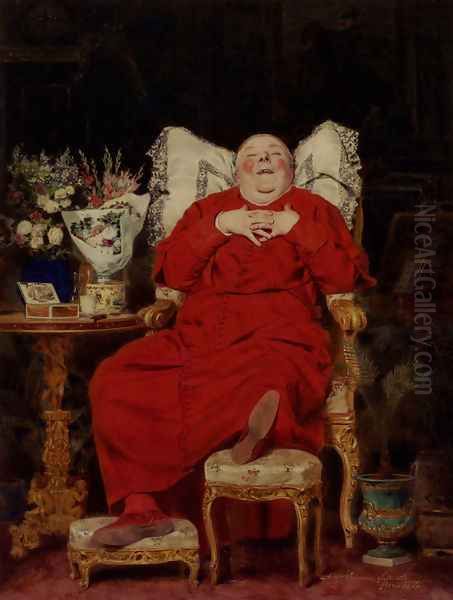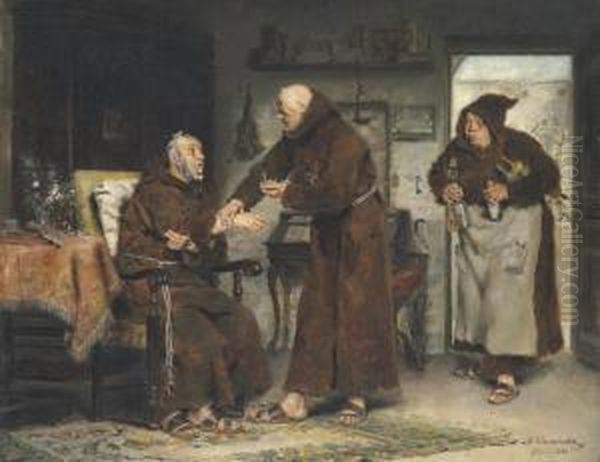Antonio Salvador Casanova y Estorach (1847–1896) stands as a significant, if sometimes overlooked, figure in the landscape of 19th-century Spanish art. A painter whose career bridged the artistic currents of his native Spain and the vibrant art world of Paris, Casanova y Estorach carved a distinct niche for himself. He is primarily celebrated for his contributions to the Costumbrista movement, infusing it with a romantic sensibility and a particular fondness for genre scenes, often featuring ecclesiastics in moments of worldly enjoyment. His meticulous technique, combined with a charming, often humorous, narrative quality, ensured his popularity during his lifetime and offers a fascinating window into the tastes and cultural nuances of the period.
Early Life and Artistic Formation in Spain
Born on September 8, 1847, in Tortosa, a town in Catalonia, Spain, Antonio Casanova y Estorach displayed artistic inclinations from a young age. His formal training placed him under the tutelage of some of Spain's most respected academic painters of the time. He studied with Federico de Madrazo y Kuntz (1815–1894), a dominant figure in Spanish art, renowned for his elegant portraiture and his directorship of the Prado Museum. Madrazo, himself part of an artistic dynasty, would have instilled in Casanova y Estorach a strong foundation in academic draftsmanship and composition.
Another key influence during his formative years was Claudio Lorenzale i Sugrañes (1814–1889), a prominent Catalan painter associated with the Nazarene movement in Spain. Lorenzale's emphasis on historical and religious subjects, often rendered with a purist aesthetic, would have provided Casanova y Estorach with a different, yet complementary, artistic perspective. Under these masters, the young artist honed his skills, and his prodigious talent was soon recognized. By the age of nineteen, he was already exhibiting his works in major artistic centers like Madrid and Barcelona, signaling the arrival of a promising new painter.
The Parisian Sojourn and Mature Career

In 1867, seeking broader artistic horizons and opportunities, Casanova y Estorach made a pivotal decision to move to Paris. The French capital was, at this time, the undisputed center of the Western art world, a melting pot of established academic traditions and burgeoning avant-garde movements. He would spend the remainder of his life in Paris, a city that undoubtedly shaped his mature style while allowing him to retain his distinct Spanish artistic identity.
Living and working in Paris exposed Casanova y Estorach to a diverse range of artistic influences. While Impressionism was beginning to challenge academic norms, the Paris Salon still favored meticulously rendered historical and genre paintings. It was within this context that Casanova y Estorach found success. He became known for his charming and often anecdotal paintings, which appealed to the tastes of a bourgeois clientele that appreciated technical skill and engaging subject matter. His Spanish roots, however, continued to inform his choice of themes and the overall flavor of his work.
Artistic Style: Romanticism and Costumbrismo
Casanova y Estorach's art is most accurately categorized within the Costumbrista tradition, imbued with a strong Romantic undercurrent. Costumbrismo, a genre particularly popular in 19th-century Spain, focused on depicting everyday life, local customs, traditions, and types. It was, in part, a response to a growing sense of national identity and an interest in preserving the picturesque elements of Spanish culture in an era of modernization. Artists like Eugenio Lucas Velázquez (1817–1870) and Leonardo Alenza y Nieto (1807–1845) were earlier exponents of this style, often with a Goya-esque satirical edge.
Casanova y Estorach’s approach to Costumbrismo was less about social critique and more about a romanticized and often humorous observation of human nature. His paintings are characterized by a high degree of finish, careful attention to detail, rich colors, and a smooth, polished surface. He excelled in capturing textures – the sheen of silk, the richness of velvet, the gleam of polished wood – which added to the tactile appeal of his works. His figures, often described as "plump" and "amiable," contribute to a general atmosphere of bonhomie and light-heartedness.
Thematic Focus: Ecclesiastics and Everyday Merriment
While Casanova y Estorach painted historical scenes and subjects drawn from folklore, he became particularly renowned for his depictions of ecclesiastics – monks, friars, and cardinals. However, these were not typically solemn religious portrayals. Instead, he specialized in showing these figures in moments of leisure and worldly pleasure: enjoying a good meal, tasting wine, engaging in witty conversation, or celebrating an occasion. These "rosy-cheeked, mischievous" churchmen are often depicted with a gentle humor, highlighting their human side rather than their spiritual austerity.

This thematic niche, sometimes referred to as "cardinal painting" or "monk painting," was popular in the 19th century, not only in Spain but also in France with artists like Jehan Georges Vibert (1840–1902), though Vibert's portrayals often carried a sharper, more anticlerical satire. Casanova y Estorach's approach was generally more benign and affectionate, focusing on the picturesque and anecdotal qualities of these scenes. His figures are often caught in unguarded moments, their expressions and gestures conveying a sense of conviviality and simple enjoyment.
Representative Works
Several works exemplify Casanova y Estorach's characteristic style and thematic preoccupations:
Preparándose (Ready, 1874): This title suggests a scene of anticipation, likely rendered with his typical attention to costume and setting, capturing a moment before an event or social gathering.
El botín de la víctima (The Victim's Booty, 1875): This intriguing title hints at a narrative scene, possibly historical or anecdotal, where the interplay of characters and the depiction of objects would be central to the story.
Los favoritos de la corte (The Court Favorites, 1877): A subject that allowed Casanova y Estorach to indulge in the depiction of lavish costumes and opulent interiors, characteristic of courtly life. Such scenes were popular for their historical romance and visual richness.
Van Dyck en el Chocolate (Van Dyck at the Chocolate, 1875): This painting likely imagines the famous Flemish painter Anthony van Dyck (1599–1641) in a relaxed, perhaps anachronistically Spanish, setting enjoying chocolate, a popular beverage. It showcases Casanova's interest in historical figures placed in genre settings.
The Sick Monk (1880): This work demonstrates his focus on monastic life, perhaps depicting a monk being tended to, allowing for a scene of quiet domesticity and human concern within a clerical context.
Monk Testing Wine (1886): A quintessential Casanova y Estorach theme, this painting would undoubtedly feature a connoisseur monk, perhaps in a well-stocked cellar, savoring the qualities of a vintage. Such scenes combined the picturesque appeal of monastic settings with the universal pleasure of good wine.
A Happy Birthday (1892): This later work likely portrays a celebratory scene, filled with the cheerful figures and detailed settings that were his hallmark, possibly featuring his favored ecclesiastics in a moment of festive camaraderie.
These works, and others like them, underscore his ability to create engaging narratives within meticulously rendered environments, appealing to the public's desire for both technical skill and relatable, often amusing, storytelling.
Influences, Contemporaries, and Artistic Milieu
Casanova y Estorach's artistic development was shaped by his teachers, Federico de Madrazo and Claudio Lorenzale, who provided him with a solid academic grounding. However, perhaps the most significant contemporary influence, particularly in terms of style and subject matter, was Mariano Fortuny y Marsal (1838–1874). Fortuny was an international sensation, a Spanish painter whose dazzling technique, vibrant colors, and exotic or historical genre scenes (often small-scale "tableautins") captivated audiences across Europe and America. Fortuny's meticulous detail, brilliant light, and often Rococo-revival themes set a trend for many Spanish artists, and Casanova y Estorach's work shares some of these "Fortunysta" characteristics, especially the jewel-like precision and anecdotal charm.
Living in Paris, Casanova y Estorach would have been aware of the broader currents of European art. He was a contemporary of the French academic masters like Jean-Léon Gérôme (1824–1904) and William-Adolphe Bouguereau (1825–1905), whose polished finish and historical or mythological subjects dominated the Salons. He would also have known of genre painters like Ernest Meissonier (1815–1891), famed for his incredibly detailed small-scale historical and military scenes. While Casanova y Estorach developed his own niche, the prevailing taste for detailed, narrative painting certainly provided a supportive environment for his work.
Other Spanish painters were also active in this period, contributing to the richness of 19th-century Spanish art. Francisco Pradilla Ortiz (1848–1921), a contemporary, was known for his large-scale historical paintings. Artists like José Villegas Cordero (1844–1921) and Martín Rico Ortega (1833–1908) also found international success, often working in Rome or Paris and specializing in genre scenes or luminous cityscapes and landscapes, respectively. The works of Ricardo Vera y Ch Rubio (1850-1910) and Manuel Ramírez Ibáñez (1856-1925) also form part of this vibrant generation of Spanish artists who often combined academic training with an interest in genre and historical subjects. Even later figures like Joaquín Sorolla (1863–1923), though primarily known as an Impressionist, began his career with more traditional genre and historical scenes.
Major Achievements and Exhibitions
Antonio Casanova y Estorach's primary achievement lies in his skillful and charming contributions to the Costumbrista genre, particularly his unique focus on the everyday lives of ecclesiastics. He successfully carved out a market for these works, which were appreciated for their technical finesse, humor, and narrative appeal. His participation in significant exhibitions, such as the National Art Exhibition in Madrid in 1884, attests to his recognition within the Spanish art world, even while being based in Paris. His works were likely also exhibited in Parisian Salons, a crucial venue for artists seeking international acclaim and patronage during this period.
His ability to capture the zeitgeist of a certain segment of the art market – one that valued craftsmanship, storytelling, and a touch of romantic nostalgia – ensured his success. He provided an alternative to both the grandiosity of official history painting and the radical innovations of the emerging avant-garde, offering instead a world of intimate, beautifully rendered, and often amusing vignettes.
A Note on a Famous Namesake
It is important to distinguish Antonio Salvador Casanova y Estorach, the painter, from his near-contemporary (though from a different field and earlier generation), the far more famous Giacomo Casanova (1725–1798), the Venetian adventurer and author renowned for his amorous exploits and detailed memoirs, Histoire de ma vie. The provided source material itself seems to have momentarily conflated information about the painter with anecdotes pertaining to Giacomo Casanova.
For clarity, the painter Antonio Salvador Casanova y Estorach was not known for the kind of adventurous or scandalous life associated with Giacomo. His "exploits" were artistic, confined to the studio and the salon, and his legacy is built on his canvases rather than on daring escapes or romantic conquests. The shared surname is purely coincidental, and their lives and contributions belong to entirely different spheres.
Legacy and Conclusion
Antonio Salvador Casanova y Estorach passed away in Paris in December 1896, at the relatively young age of 49. He left behind a body of work that continues to charm viewers with its technical skill, warmth, and gentle humor. As a prominent exponent of late 19th-century Costumbrismo, he captured a specific facet of social observation, romanticizing everyday life and finding the picturesque in unexpected corners, particularly within monastic walls.
While perhaps not as revolutionary as some of his contemporaries, Casanova y Estorach played a valuable role in the artistic ecosystem of his time. He catered to a significant public taste for well-crafted, narrative paintings that offered an escape into charming, idealized worlds. His work serves as a delightful record of certain 19th-century sensibilities and remains a testament to his skill as a draftsman, colorist, and storyteller in paint. He remains an important figure for understanding the diversity of Spanish art in the latter half of the 19th century and its engagement with broader European artistic trends, particularly those centered in Paris. His paintings continue to be appreciated in collections and at auction for their enduring appeal and masterful execution.